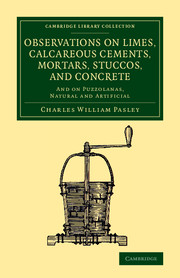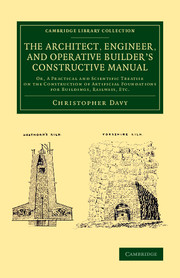Refine search
Actions for selected content:
2643 results in Civil and geotechnical engineering
Index
-
- Book:
- Robot-Oriented Design
- Published online:
- 05 May 2015
- Print publication:
- 05 May 2015, pp 275-283
-
- Chapter
- Export citation
Robot-Oriented Design - Title page
-
-
- Book:
- Robot-Oriented Design
- Published online:
- 05 May 2015
- Print publication:
- 05 May 2015, pp iii-iii
-
- Chapter
- Export citation

Observations on Limes, Calcareous Cements, Mortars, Stuccos, and Concrete
- And on Puzzolanas, Natural and Artificial
-
- Published online:
- 18 December 2014
- Print publication:
- 22 May 2014
- First published in:
- 1838

The Architect, Engineer, and Operative Builder's Constructive Manual
- Or, A Practical and Scientific Treatise on the Construction of Artificial Foundations for Buildings, Railways, etc.
-
- Published online:
- 05 December 2014
- Print publication:
- 10 July 2014
- First published in:
- 1839
Contents
-
- Book:
- The History of the Drainage of the Great Level of the Fens, Called Bedford Level
- Published online:
- 05 June 2015
- Print publication:
- 20 November 2014, pp xi-xvii
-
- Chapter
- Export citation
CHAPTER III
-
- Book:
- The History of the Drainage of the Great Level of the Fens, Called Bedford Level
- Published online:
- 05 June 2015
- Print publication:
- 20 November 2014, pp 54-68
-
- Chapter
- Export citation
No. 19 - General Act for settling the Draining, 1663
-
- Book:
- A Collection of the Laws Which Form the Constitution of the Bedford Level Corporation
- Published online:
- 05 June 2015
- Print publication:
- 20 November 2014, pp 383-425
-
- Chapter
- Export citation
No. 23 - First Style Act, 1750
-
- Book:
- A Collection of the Laws Which Form the Constitution of the Bedford Level Corporation
- Published online:
- 05 June 2015
- Print publication:
- 20 November 2014, pp 522-523
-
- Chapter
- Export citation
No. 13 - The Indenture of Fourteen parts, 1631
-
- Book:
- A Collection of the Laws Which Form the Constitution of the Bedford Level Corporation
- Published online:
- 05 June 2015
- Print publication:
- 20 November 2014, pp 111-120
-
- Chapter
- Export citation
CHAPTER XXII
-
- Book:
- The History of the Drainage of the Great Level of the Fens, Called Bedford Level
- Published online:
- 05 June 2015
- Print publication:
- 20 November 2014, pp 660-691
-
- Chapter
- Export citation
Dedication
-
- Book:
- A Collection of the Laws Which Form the Constitution of the Bedford Level Corporation
- Published online:
- 05 June 2015
- Print publication:
- 20 November 2014, pp iii-iv
-
- Chapter
- Export citation
CHAPTER VIII
-
- Book:
- The History of the Drainage of the Great Level of the Fens, Called Bedford Level
- Published online:
- 05 June 2015
- Print publication:
- 20 November 2014, pp 146-195
-
- Chapter
- Export citation
No. 18 - Pretended Act for Draining the Great Level of the Fens, 1649
-
- Book:
- A Collection of the Laws Which Form the Constitution of the Bedford Level Corporation
- Published online:
- 05 June 2015
- Print publication:
- 20 November 2014, pp 367-382
-
- Chapter
- Export citation
CHAPTER XXV
-
- Book:
- The History of the Drainage of the Great Level of the Fens, Called Bedford Level
- Published online:
- 05 June 2015
- Print publication:
- 20 November 2014, pp 752-792
-
- Chapter
- Export citation
No. 29 - Second Bond Act, 1772
-
- Book:
- A Collection of the Laws Which Form the Constitution of the Bedford Level Corporation
- Published online:
- 05 June 2015
- Print publication:
- 20 November 2014, pp 669-682
-
- Chapter
- Export citation
CHAPTER I
-
- Book:
- The History of the Drainage of the Great Level of the Fens, Called Bedford Level
- Published online:
- 05 June 2015
- Print publication:
- 20 November 2014, pp 1-43
-
- Chapter
- Export citation
CHAPTER IV
-
- Book:
- The History of the Drainage of the Great Level of the Fens, Called Bedford Level
- Published online:
- 05 June 2015
- Print publication:
- 20 November 2014, pp 69-77
-
- Chapter
- Export citation
PREFACE
-
- Book:
- The History of the Drainage of the Great Level of the Fens, Called Bedford Level
- Published online:
- 05 June 2015
- Print publication:
- 20 November 2014, pp v-x
-
- Chapter
- Export citation
No. 21 - Tax Act and Schedules, 1667
-
- Book:
- A Collection of the Laws Which Form the Constitution of the Bedford Level Corporation
- Published online:
- 05 June 2015
- Print publication:
- 20 November 2014, pp 474-518
-
- Chapter
- Export citation
No. 30 - Turf Act, 1782
-
- Book:
- A Collection of the Laws Which Form the Constitution of the Bedford Level Corporation
- Published online:
- 05 June 2015
- Print publication:
- 20 November 2014, pp 682-691
-
- Chapter
- Export citation
